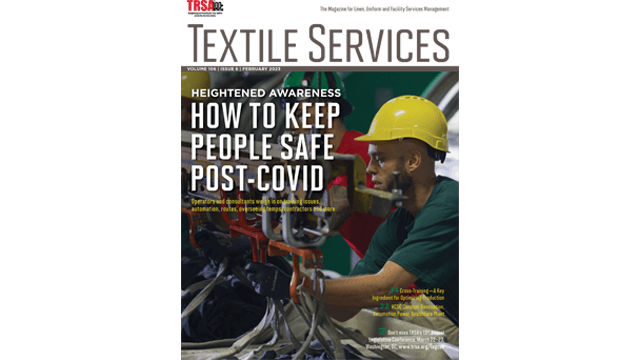Coming Soon … ‘Heightened Awareness’ – Safety Post-COVID

TRSA’s February issue of Textile Services will feature a cover article on safety issues and how attitudes have shifted following the recent COVID-19 pandemic.
In the article, titled “Heightened Awareness: How to Keep People Safe Post-COVID” operators and safety consultants reflect on the impact of the pandemic and its lingering effects, along with ongoing issues, such as ergonomics and OSHA’s new excessive-heat rule.
“I think it just broadened the scope,” said Michelle McNeil, Healthcare Linen Services Group (HLSG), in the forthcoming article on safety and the pandemic. “Getting to the core is what’s important in order to manage the risks.” Speaking from HLSG’s headquarters in St. Charles, IL, McNeil cites the need for a customized approach to health and safety, especially in an environment like the pandemic, where conflicting guidance from government sometimes made risk management more difficult, she said. “Our industry is different and will continue to be for these situations. I don’t think it is a one-size-fits-all solution.”
Other safety professionals quoted in the article describe a range of concerns. Among these are the rise in absenteeism since the pandemic hit and the increased reliance of linen, uniform and facility services companies on temporary labor to service customer accounts. Don Bock, a consultant and principal with Seabright Safety Solutions, Santa Maria, CA, said that not all companies have kept sufficient tabs on their temp labor and the various contractors that enter the plant to make repairs or do installations. “COVID-19 has substantially changed the way that companies need to look at risk management/safety,” said Bock. For example, companies must ensure that all temp laborers are fully trained to deal with industry-specific hazards before entering production areas. “The training must include safety training,” Bock said. “I believe companies believe that this responsibility falls to the temp agency. The temp agency is to provide safety training, but this training will not address the situations or conditions that the temporary employees will face on the job. This attitude presents a much greater risk of injury resulting from individual actions.”
Meanwhile, the consequences of workplace incidents – even minor mishaps – can have a corrosive effect on staff morale and recruitment/retention, as well as financial consequences, including workers’ compensation costs. Brian Varner, a risk-management consultant and recent instructor at TRSA’s Professional Management Institute (PMI), noted that taking a proactive approach to risk management with temps can help companies not only avoid the negative consequences of such incidents, but also prevent hikes in insurance premiums. “Even though contractors and temp employees fall under their companies’ workers’ compensation programs, even if it is discovered that the incident was a result of a facility worker not following procedure and as a result the contractor or temp employee is injured, the facility would need to record this as a general liability,” said Varner of Safety Solutions for Healthcare, Denver. “It is critical that safety programs and procedures are in place for all personnel on-site. It’s also important that the contractor and temp employees understand that they must follow the same safety protocols as the facility employees.”
Michael Halter, director of loss control for Haylor, Freyer & Coon, Syracuse, NY, adds that laundry operators need to carefully scrutinize the experience modification rating (EMR) of all contractors to ensure that they take safety seriously. Contract language should also require contractors to adhere to risk-transfer policies and other terms, he said.
Other challenges addressed in the article include:
- Automation: A commercial laundry safety specialist notes that while enhanced automation has reduced the likelihood of cuts and other minor injuries, unless these systems are properly maintained, they can pose a higher risk of serious injuries. For example, if an employee enters an area of a moving wash-aisle shuttle that’s not equipped with a functioning automatic-shutdown mechanism, they’re at risk of a life-threatening incident.
- Ergonomics: While technology is advancing rapidly, most plants still rely on hourly staff to sort soiled items by hand and manually feed clean goods into ironers or folding equipment. The article cites experts who discuss the use of cross-training staff to reduce the risk of repetitive-stress injuries. Making minor adjustments to workspaces to accommodate the physical dimensions (e.g., height, reach) of employees also can help ease the strain on muscles and joints.
Click here for a sneak preview of “Heightened Awareness: How to Keep People Safe Post-COVID,” the cover article in February’s issue of Textile Services magazine, TRSA’s award-winning monthly publication.
